Realising Realistic Medicine: Chief Medical Officer for Scotland annual report 2015-2016
Report on the adoption of the personalised, patient-centred Realistic Medicine approach in Scotland's health services.
The Health of the Nation Summary
This chapter provides some key data on public health. It is intended as a snapshot summary. I hope it serves a useful purpose to make you aware of some key trends.
Scotland's health data is available online and the Public Health Information Network for Scotland ( PHINS) is a useful source for professionals to share intelligence and expertise.
http://www.scotpho.org.uk/about-us/public-health-information-network-for-scotland-phins
Communicable Diseases
Travel and International Health
As part of its remit to protect the health of the Scottish public, Health Protection Scotland ( HPS) supports service provision covering the following areas:
- Risks and interventions related to travelling abroad
- New and emerging risks abroad and imported infections
- Migrant health, port health and International Health Regulations
- Yellow fever vaccinating centres.
In 2015 21 , there were approximately 3.96 million journeys abroad from Scotland, representing 6% of total journeys from the UK. This was a very slight increase over the previous year's figure of 3.9 million.
Risks and interventions related to travelling abroad
With respect to travellers going abroad, HPS continue to maintain two evidence-based, travel health advice websites. TRAVAX ( www.travax.nhs.uk) is aimed at health professionals and assists with pre- and post-travel assessment, and fitfortravel ( www.fitfortravel.nhs.uk) is directed at the travelling public. Both sites highlight developing issues and rely on competent assessment of real-time data on risks abroad, along with clinical and epidemiological evidence, to produce timely and appropriate advice and recommendations for actions. Travellers are strongly advised to consult the fitfortravel website in advance of their journey for information on how to stay healthy abroad.
Key pieces of advice and guidance which were written or updated during 2015-16 included: mental health for travellers; diabetes advice; female genital mutilation; Zika virus guidance; and country-specific vaccine recommendations for TB, tetanus, typhoid, hepatitis B, cholera, meningococcal, Japanese encephalitis, yellow fever, tickborne encephalitis and poliomyelitis. In addition, the Scottish Malaria Advisory Group ( SMAG) continued to develop its methods and provide up-to-date advice, guidance and malaria maps.
Imported infections
Those infections which are reported to HPS as imported are included in the annual totals of travel-related infection published in January each year 22 . A separate malaria report is published in July 23 .
As in previous years, organisms causing traveller's diarrhoea ( TD) were most frequently reported in 2015. Notably there were outbreaks of cyclosporiasis, linked to travel to Mexico, in both 2015 and 2016 with a large number of Scottish travellers affected. Travellers to the Riviera Maya coast in Mexico were being advised to take careful precautions with food, water and personal hygiene and a leaflet for travellers was produced in collaboration with Public Health England 24 .
New and Emerging Diseases
HPS continually and systematically carries out risk assessments of new and emerging hazards, including non-infectious hazards. In the context of travel abroad assessments highlighted the continued need to be vigilant with respect to viral haemorrhagic fevers. Even as the West African Ebola outbreak began to decrease, new observations of Zika virus required an evidence-based and co-ordinated response to ensure risk to travellers and particularly developing fetuses was reduced to a minimum.
Ebola
From the beginning of the West African Ebola virus disease ( EVD) outbreak at the end of 2013, Health Protection Scotland provided straightforward, evidence-based guidance both on the realistic risk of imported cases of Ebola as well as guidance and infrastructure required to deal with the identification, care and
follow-up of any potential case. Critically HPS was involved in helping co-ordinate follow-up of volunteers returning to Scotland from the affected area. There is increasing literature on Ebola persistence and recrudescence that suggests that West African health systems will be required to cope with apparently healthy individuals who unexpectedly become unwell.
Zika
In early 2015 the first outbreaks of Zika virus ( ZIKV) infection were reported from South and Central America; since then cases have been reported from more than 65 countries, notably most of the Caribbean Islands. Of concern was the strong evidence of causation between ZIKV and neuro-developmental defects, in particular microcephaly in newborns. ZIKV was declared a Public Health Emergency of International Concern ( PHEIC) by WHO on 1 February 2016.
In the UK there have been more than 250 cases of ZIKV diagnosed since 2015, the majority associated with travel to South, Central America and the Caribbean. The risk to Scotland is considered very low due to the absence of the Aedes mosquito vector and the low risk associated with sexual transmission. For pregnant travellers or for women who may become pregnant during or soon after travel, however, the risk is considered higher 25 . HPS has issued specific travel advisories for this group and stress the importance of avoiding mosquito bites in areas where the virus is present. HPS will continue to monitor the situation and work collaboratively with colleagues across the UK, including primary care, obstetrics, midwifery and infectious diseases to ensure appropriate and timely advice and guidance is produced in response to this emerging threat.
Migrant Health
HPS has been collaborating with other national and international colleagues to develop resources and provide support, in this area 26 . From a European perspective the ongoing mass immigration of people from Africa and the Middle East has presented challenges for health and social services. Throughout 2015, migrants continued to arrive in Europe via Turkey and Italy, with many seeking to settle in Germany and Northern Europe. In late 2015, Scotland began to receive refugees from the conflict in Syria under the UK Vulnerable Persons Relocation scheme. While it has been reported that a large proportion of migrants from the Middle East are young men, the majority arriving in Scotland are families who have been accommodated in various parts of the country.
Immigrants to Scotland and the wider EU are usually in good health, although migration renders some vulnerable to illness and injury, depending on their circumstances of travel and subsequent accommodation. The current migration brings few, if any, unfamiliar infections to Europe and there is no strong association between migration and the importation of infectious diseases that pose a serious risk to the resident population of Europe. In the context of migration, health professionals seeing newly arrived migrants presenting with infectious disease are encouraged to liaise appropriately with laboratory staff, infectious disease clinicians and health protection teams.
HAI and AMR Summary
Healthcare-associated infections ( HAI) and antimicrobial resistance ( AMR) pose a real threat to the health of the people of Scotland. The European Centre for Disease Control ( ECDC) has recently estimated that HAI account for twice the burden of 32 other communicable diseases 27 . Similarly, the World Health Organization ( WHO) Global Health Observatory data repository demonstrates that HAIs in high-income countries have a greater effect on health than most other communicable diseases.
Gram-Negative Bacteraemia
Gram-negative bacteria are now emerging as a substantial risk to health worldwide. In Scotland, Escherichia coli (E. coli) are the most common Gram-negative pathogens causing bacteraemia in community and healthcare settings. During 2015, there were 4,596 cases of E. coli bacteraemia ( ECB), approximately half of which were
healthcare-associated (Figure 1).
Figure 1: Annual incidence of ECBs per 100,000 acute bed days, for all ages
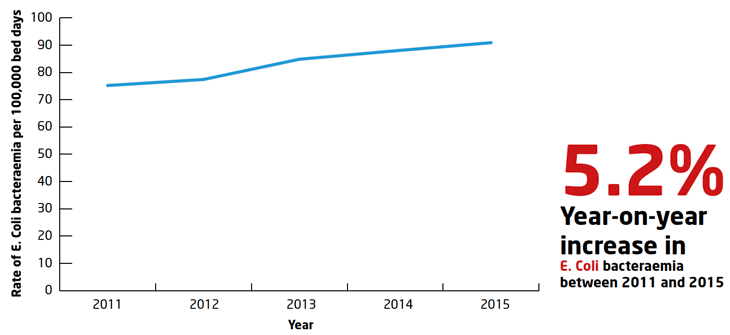
In response, Health Protection Scotland ( HPS) working with NHS Board infection control teams implemented mandatory ECB enhanced surveillance in April 2016 to inform the future infection prevention interventions required in Scotland to control these serious infections. Bacteraemia typically develops as a complication of infections such as: i) urinary tract infections ( UTIs), ii) infections following surgery, and iii) infections associated with medical devices ( e.g. central venous catheters). Therefore, reducing rates of ECB involves prevention of UTIs, surgical site infections ( SSIs) and catheter-related infections ( CRIs).
Whilst SSIs and CRIs are predominantly hospital-based, the prevention of UTIs requires collaboration across the entire healthcare service. The Scottish UTI Network ( SUTIN) works with primary care, community healthcare workers, care homes, infection prevention and control teams, and health protection teams to ensure that catheters are only used when, and for as long as, they are absolutely necessary; and are inserted, managed and withdrawn with strict adherence to infection prevention control measures.
Antimicrobial Resistance
Multidrug resistance among Gram-negative bacteria is a major concern for public health and patient safety. Carbapenems are a group of broad-spectrum antibiotics which are used in the hospital setting to treat multidrug-resistant infections. The emergence of organisms which have developed resistance to these antibiotics, for example carbapenemase-producing organisms ( CPOs), are of particular concern as few other treatments are available for these infections. In 2015, a total of 66 CPOs were reported to HPS: an increase of 40% from 2014. This change mirrors the steady rise in secondary care use of carbapenems over recent years (Figure 2).
Figure 2: Reported numbers of CPOs against secondary care use of carbapenems Scotland 2011-2015
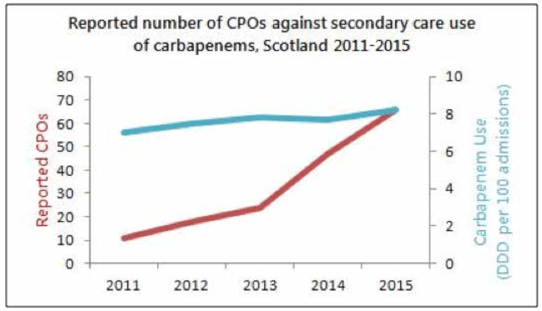
It is critical to preserve the use of carbapenems due to a lack of new antibiotics currently under development. The Scottish Antimicrobial Prescribing Group ( SAPG) has developed guidance to support the clinical management of infections caused by Gram-negative bacteria, aiming to restrict the use of carbapenems for the treatment of those infections which cannot be treated using other antibiotics.
There is a need for members of the public to play their role in tackling antimicrobial resistance by only taking antibiotics as advised by healthcare professionals. The Control of Antimicrobial Resistance in Scotland ( CARS) team in HPS has adopted a 'one health' approach, ensuring that those prescribing antibiotics for humans, animals or in agriculture all understand the risk from AMR and work together to preserve antibiotics.
Immunisation
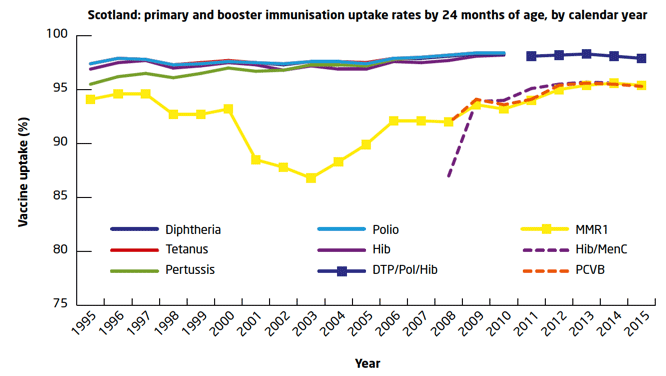
Source: SIRS
Summary Point:
At Scotland level, uptake rates by 24 months remained high and exceeded 95%. This includes primary courses of immunisation against diphtheria, tetanus, polio and Hib (the five-in-one vaccine), measles, mumps and rubella ( MMR), and booster doses for immunisation against pneumococcal disease ( PCV), meningococcal C disease and Haemophilus influenzae type b (Hib/MenC).
Blood borne viruses and sexually transmitted infections
HIV
- HIV remains a public health challenge with evidence of ongoing transmission in the population. During 2015/2016, one-third (34.8%) of men who have sex with men newly diagnosed in Scotland had laboratory markers consistent with recent acquisition of infection, that is within the previous three to four months. A Short Life Working Group ( SLWG) met during 2016 to deliver recommendations to the Scottish Government (Sexual Health and Blood Borne Virus Executive Leads) on the use of HIV pre-exposure prophylaxis ( PrEP) in Scotland. A number of clinical trials have now reported that PrEP is highly effective in preventing HIV transmission. The SLWG strongly recommends the provision of PrEP, for those at the highest risk of infection, as part of a wider targeted national prevention programme. This is recommended to be delivered by the NHS in sexual health services, subject to cost-effective delivery of the programme.
- An outbreak of HIV among people who inject drugs in Greater Glasgow & Clyde ( GGC), originally identified in 2015, continued in 2016. GGC typically records around 10 new diagnoses of HIV associated with injecting drug use each year; 42 new diagnoses with this risk were reported in 2015 and a further 18 by September 2016, the majority with subtype-C virus. Data indicates that this increase in diagnoses is related to transmission among a population who mainly inject heroin with or without cocaine in Glasgow city centre, many of which are homeless. This outbreak is being managed through increasing awareness of the risks of HIV, education of the at-risk population and addiction services regarding HIV, increasing provision of needle and syringe programmes ( e.g. greater evening availability), improving the frequency of HIV testing and its accessibility, and proactively supporting the early treatment of those newly diagnosed so as to reduce the risk of onward transmission.
Hepatitis C
- A 36% increase (from12,71 in 2014/15 to 1,724 in 2015/16) in the number of Hepatitis C virus ( HCV) infected people initiated onto Hepatitis C treatment was observed. With the majority being administered the new direct acting antiviral therapies, it is estimated that nearly 90% of the 1,724 cleared their infection. Accordingly, the Scottish Government target of 1,500 treated persons for 2015/16 was well exceeded.
- With most of those treated for Hepatitis C virus having moderate to severe liver disease, in accordance with Scottish Government guidance, it is encouraging that the upward trend in new presentations of HCV-related severe liver disease, observed over the last two decades, has halted. Indeed, in 2015, a 22% reduction from 156 to 121 was seen - a change consistent with the Scottish Government target of a 75% reduction in such morbidity during 2015-2020.
- In response to recommendations from a Short Life Working Group led by Health Protection Scotland, in September 2016 the Scottish Government launched a Hepatitis C testing campaign targeted at people who had a blood transfusion before September 1991 but who had not previously been tested for Hepatitis C. It is estimated that less than 50 people who belong to this group are alive and infected.
Immunisation
Since the beginning of 2015, immunisation programme achievements include:
- Latest quarterly figures for December 2016 indicate that uptake of the Meningococcal B vaccine by 12 months for children born between July and September 2015 was high at 94.5%. This is the first published data for the Meningococcal B immunisation programme, which was introduced in September 2015.
- Offering vaccination against Meningococcal ACWY for new university entrants (from August 2015) and all those 14-18 years. The schools programme concluded in March 2016 with high uptake (82.1% in S3).
- Early evidence of eliminating the steep cervical cancer deprivation gradient among young women who received HPV vaccine.
- Demonstrating effectiveness of seasonal nasal flu vaccine offered to all children from the age of two years to the end primary school.
- Maintaining high uptake of established childhood immunisations across all deprivation categories.
Life Expectancy and Healthy Life Expectancy
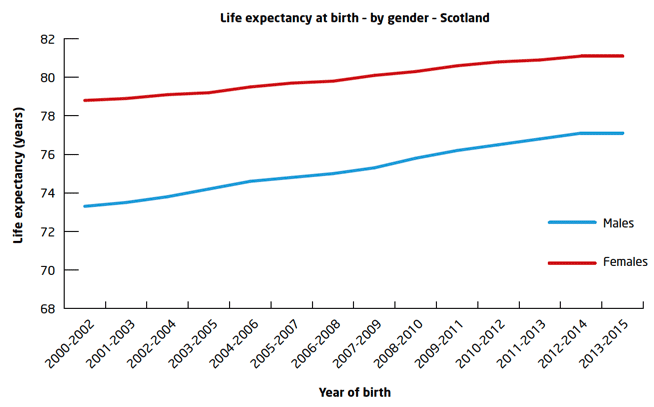
Source: National Records of Scotland
Summary Points:
Since the start of the century, life expectancy at birth for men has increased from just over 73 years to just over 77 years. For women, the increase has been from just under 79 years to just over 81.
We continue to see a significant gap in life expectancy between men and women. Indication of a slight reduction over the last 15 years from a gap of five and a half years to a gap of four years.
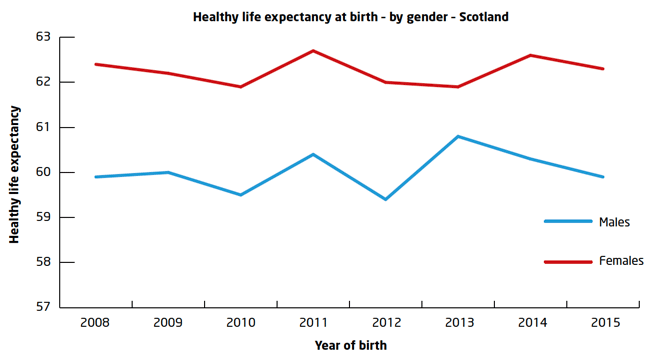
Source: National Records of Scotland
Summary Point:
There continues to be a significant gap in healthy life expectancy ( HLE) (at birth) between men and women. Women's HLE at birth over the last few years is currently around 62 ½ years, compared with an average for men of around 60 years.
Premature Mortality
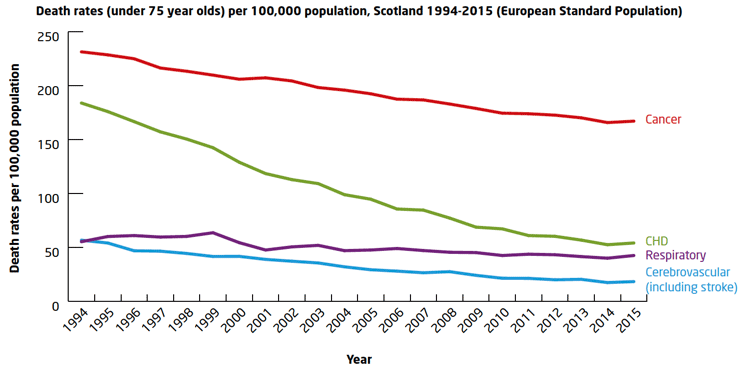
Source: Information Services Division, NSS
Summary Point:
The reduction in premature mortality (all causes) has been 36% between 1994 and 2015. This drop has been driven by the 28% drop in premature deaths caused by cancer, the 71% drop due to coronary heart disease, and the 68% drop due to cerebrovascular disease.
Obesity
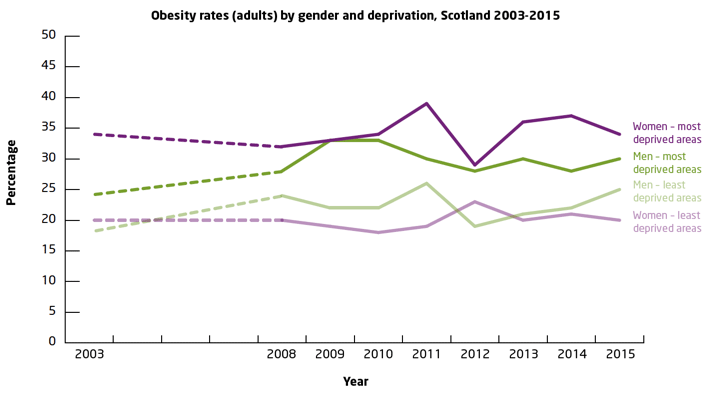
Source: Scottish Health Survey
Summary Point:
Across the adult population 65% of adults are overweight, with 29% of adults being assessed as obese. There has been little change since the start of the millennium. There continues to be a clear link to deprivation with men and women living in Scotland's more deprived communities being more likely to be assessed as obese. This gap appears more significant for women than for men.
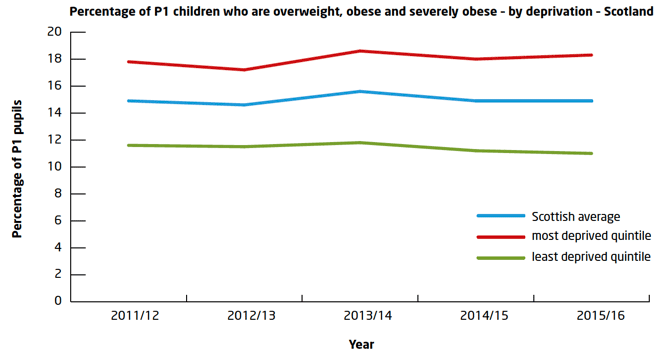
Source: Information Services Division
Summary point:
Amongst Scotland's P1 pupils, around 15% are classed as being overweight, obese or severely obese. There is also a sustained link with deprivation with over 18% of P1 pupils in Scotland's most deprived communities being overweight, obese or severely obese compared with around 11% in Scotland's least deprived communities.
The 4 UK Chief Medical Officers jointly published the infographics below in 2016 building on the success of the adult infographic in 2015.
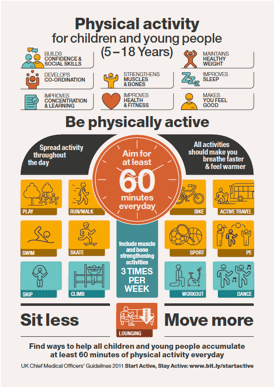
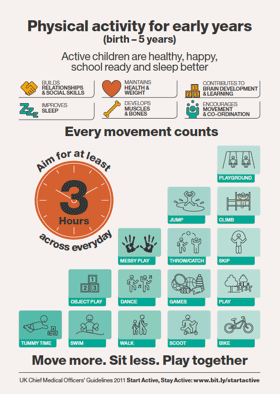
Physical Activity
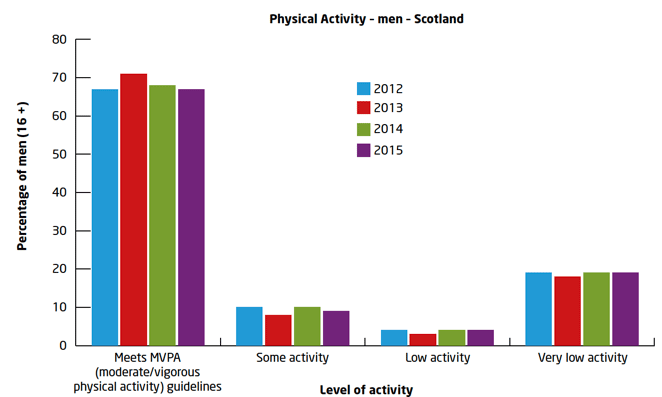
Source: Scottish Health Survey
Summary Points:
There has been relatively little change in physical activity levels (16 years and over) over the last few years, and there continues to be a difference by gender. Whilst over two-thirds of men meet physical activity guidelines, less than 60% of women do. Additionally, just under one in five men have very low levels of activity, this is closer to one in four women.
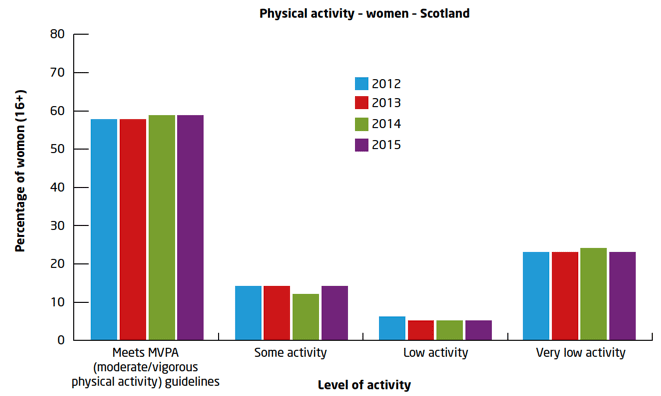
Source: Scottish Health Survey
Alcohol
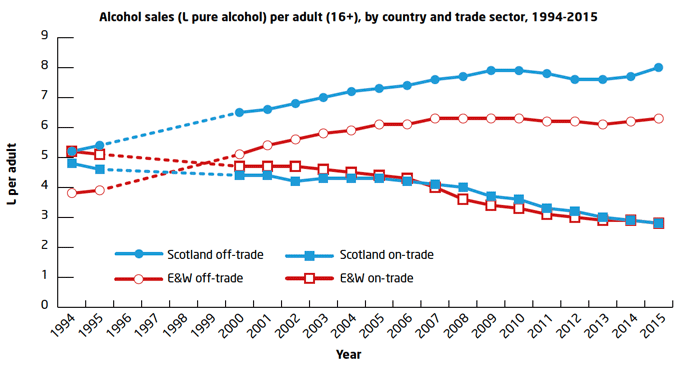
Summary Points:
Scotland continues to consume high quantities of alcohol when compared to other countries. For example, alcohol sales are around 20% higher in Scotland than in England and Wales. Sales have also increased in Scotland over the last two years, after a fall between 2009 and 2013. In 2015, 10.8 litres of pure alcohol was sold per adult; that is equivalent to 20.8 units per adult week. To put this into perspective, the UK Chief Medical Officers recommend that you do not regularly consume more than 14 units per week to keep risks from drinking alcohol to a low level. Sales of alcohol are dominated by the off-trade where the price is comparatively cheap. In 2015, 74% of alcohol was sold in supermarkets and off-licences; this was a record high. Levels of alcohol-related harm remain unacceptably high in Scotland: there are around 22 deaths on average per week due to alcohol misuse, and an average of 674 hospital admissions per week. Both deaths and hospital admissions remain many times higher than in the 1980s.
Smoking
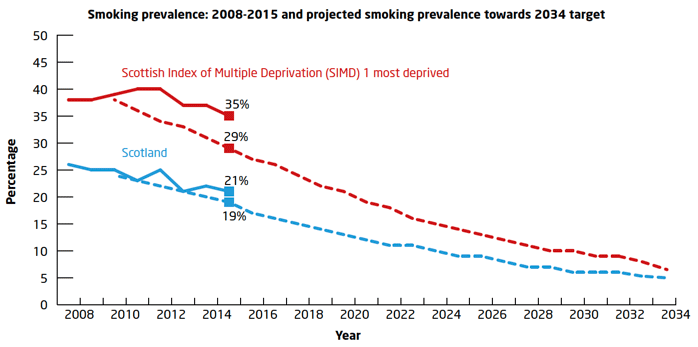
Source: Scottish Health Survey
Summary Point:
Overall the levels of smoking by adults has fallen to 21% of the adult population in Scotland. However there continues to be a significant link to deprivation, with more than one in three adults in Scotland's most deprived communities smoking.
Young Smokers
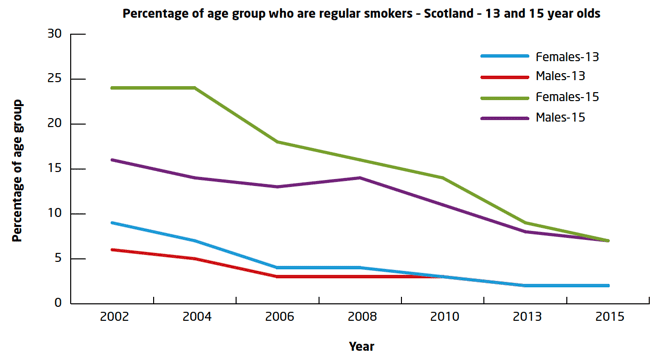
Source: SALSUS 2015
Summary Point:
There continues to be a significant fall in the level of young people who are regular smokers. Currently around 2% of 13 year olds, and 7% of 15 year olds are regular smokers. This compares with close to one in four 15 year old girls smoking regularly in 2002.
Suicide
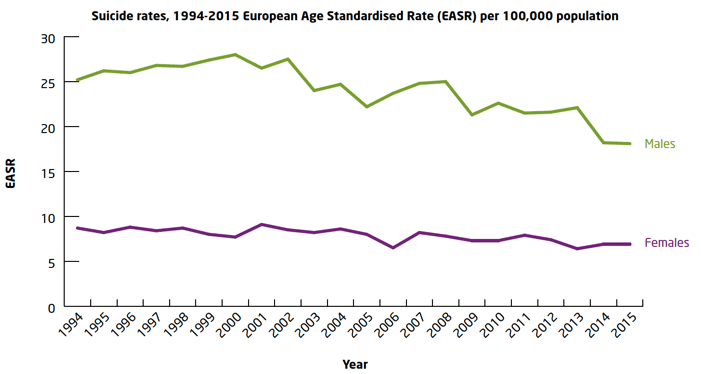
Source: National Records of Scotland
Summary Point:
There continues to be a significant difference between the suicide rates for males and females. Recent data shows that suicide rates for males are two and a half times those for females. Since the mid 1990s, the suicide rate for men has fallen by just under 30%, compared with a fall of just over 20% for females.
Cancer
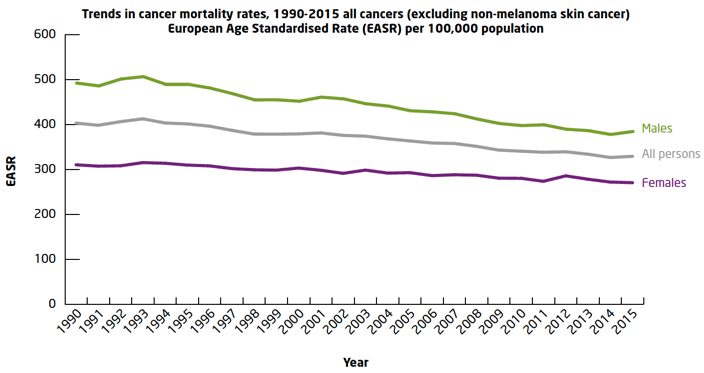
Source: Information Services Division, NSS
Summary Point:
Over the last decade the number of deaths due to cancer has continued to slowly rise - from just over 15,000 to closer to 16,000, with the number of males being slightly higher than females. However, once age has been accounted for, the mortality rates for males has fallen 10% in the last decade, and 7% for females.
Contact
Email: Catherine Calderwood
There is a problem
Thanks for your feedback